
|
|
|
|
 |
|
Home Site Search Contact Us Subscribe
|
|
|
|
"G" is for Genome (and Green): Terrence Donnelly Center for Cellular and Biomolecular Research by architectsAlliance and Behnisch Architekten
Toronto, Canada: A new campus building is a symbolic and physical bridge between an academic community and the city. by ArchNewsNow July 19, 2006 The University of Toronto’s Terrence Donnelly Center for Cellular and Biomolecular Research (TDCCBR) is Canada’s foremost human genome research center. The facility is home to 400 specialists who perform ground-breaking research in genetics and disease. Organized as a collaborative, interdisciplinary research center, TDCCBR required a facility that was functional, highly flexible, and technologically advanced.
Located at the southeast corner of the University of Toronto’s St. George campus, the 248,378-square-foot, $86 million USD/$100 million Canadian facility is in the center of the city’s densely built historic district. Formerly a small parking and service area, the narrow building site is straddled between two historic buildings on College Street, a main city thoroughfare. TDCCBR is both a symbolic and physical connection that bridges the academic community to the north, the medical community to the south, and people who live and work in the area.
Design
Standing in contrast to neighboring brick buildings, TDCCBR is a slender, elegant tower marked by a façade that is crisp, light, and colorful. In response to the narrow building site, Toronto-based architectsAlliance, and Behnisch Architekten, with offices in Stuttgart, Germany, and Los Angeles, designed a rectangular 12-story structure. The design emphasizes environmental sustainability, connections to the surrounding urban context, transparency, and informal spaces that promote collaboration among the organization’s various disciplines.
The building’s elongated, rectangular form sits between the Rosebrugh Building (circa 1919) to the west, Fitzgerald Building (circa 1920s) to the east, and Medical Science Building to the north. The colorful, glass building emerges over the neighboring structures, creating an altered cityscape that is a blend of historic and contemporary architecture.
Façades
Each elevation is treated differently, according to various programmatic and climatic requirements. The south façade – which serves as the main face of the building – is double-glazed to create a richly textured transparency, as well as to provide acoustic and solar control. The east façade is clad in color-laminated glass, while the west façade is glazed with patterned ceramic-fritted glass, which the architects used to enrich the building mass, as well as to meet privacy, shading, and amenity needs. The ceramic-frit glass has a dot-matrix pattern that manages solar gain. The western façade also includes bay-window volumes that house lounges, cafes, and stairways.
Color is used extensively in the building interior and exterior. Shades of yellow, blue, orange, and red playfully animate the eastern and western façades. The multi-hued western façade is created by the colored interior walls, which reveal themselves through the fritted, patterned glass.
To relate to the scale of surrounding buildings, TDCCBR is broken into two vertically stacked volumes, which are divided by the intermediate sixth level that houses mechanical systems for lower levels. Cinched like a belt, the mechanical level allows the laboratory floors to be flexible, open spaces free of mechanical rooms. Laboratory space is organized below the intermediate level on floors 2-5, as well as on floors 7-12. Mechanical systems serving the upper levels are located on the rooftop in an amoeba-shaped, stainless-steel volume.
Concourse
An exterior granite-paved forecourt – flanked by gardens and neighboring buildings – provides a dramatic entrance into TDCCBR. The granite pavement continues into the concourse, contributing to an indoor-outdoor sensibility that is further established by a full-height glass atrium, multi-colored skylights, and lush, interior gardens that unfold as a modulated landscape.
Extending five levels high, the atrium incorporates the historic Rosebrugh Building’s buff-colored brick façade, which was restored in the design process. The space is simply landscaped with 45-foot-high bamboo trees and Liriope grass, creating a relaxing microclimate for visitors, employees, and those passing through. The simple planting palette sets off building’s complexities, colors, and forms.
White terrazzo floors, white ceilings, exposed-concrete columns, and glass partitions play against the greenery, the pale brick wall, and the sinuous walls of three seminar rooms clad in red, black, and white glass-mosaic walls.
Designed as a north-south thoroughfare, the concourse allows the public to travel freely through the building to access the city center to the south, the university campus to the north, and existing buildings on northern, eastern, and western perimeters. The concourse also includes a cafeteria, lounges, and offices. Interior and exterior pathways establish new and maintain existing connections to surrounding buildings. TDCCBR is adjoined to the Medical Science Building through ground-level walkways and a glass bridge on the sixth level, while an upper-level connection links it to the Rosebrugh Building.
Interiors
Transparency, connectivity, and function informed the design of the interior spaces. The laboratory levels are designed in a repetitive floor plan that maximizes efficiency of space, flexibility, and access to natural light. An airy, spacious interior and increased floor-to-floor height is achieved by omitting suspended ceilings, exposing services and superstructure, and selecting simple, durable materials. Shallow floor plates and glass walls allow a high level of transparency throughout the labs; work zones are differentiated by color, lighting, and millwork.
Each level has six principal-researchers’ offices, 38 research-associate stations, lounges, cold rooms, and equipment rooms. The research-associate stations are organized in an open, loft-like space along the eastern perimeter of the building, while principal-researchers’ offices overlook the forecourt at the building front. Wet and dry laboratories are located in the central service spine, which runs north-south through the middle of each floor. The laboratories are designed for easy conversion: wet labs can be altered to accommodate biology, chemistry, or bioinformatics usage. Likewise, dry labs can be converted to wet labs by adding fume hoods and laboratory casework.
A circulation corridor on the western perimeter provides entry to the labs and research-associate stations beyond. Connected by staircases, the corridors on levels 2-5, with informal spaces for employee interaction, overlook the ground-floor atrium garden. On levels 7-12, the bay window volumes contain interconnecting stairways, lounges, and cafes. There are three double- and triple-height gardens located along the perimeters of the upper levels.
Sustainability
TDCCBR is a high-performance building that incorporates both passive and active sustainable design measures that increase energy efficiency and promote employee quality of life. The building is divided into two energy zones powered by different sources. The gardens, lounges, and corridors are operated by a mechanically-assisted natural ventilation system, whereas laboratories and offices are operated by an energy-efficient mechanical system.
In an effort to minimize the building’s overall energy requirements, the labs and offices were mechanically separated from common areas, which are able to sustain higher mean temperatures. The architects also challenged traditional ventilation standards for laboratory spaces, and reduced air changes per hour to 10-12 from more than 20.
The double façade of the south elevation has 2.5 feet of air space between the exterior single-glazed skin and the interior double-glazed skin. With sun blinds on the interior side, the single-glazed skin reduces heat loss or gain, and provides wind and acoustic protection. Retractable perforated-aluminum louvers are located between the façades. The louvers further reduce heat gain, redirect daylight into the building, and modulate the natural stack-effect to heat or vent the interstitial space. The principal-researchers’ offices on the southern side have operable windows and sun blinds, which – while controlled by individual users – are connected to the computerized Building Management System, ensuring override control. When users open the windows, programmable heating and cooling units in the ceiling switch off.
The circulation corridors, garden, and lounges are powered by a mechanically-assisted natural ventilation system. The ground-level garden atrium has a fritted-glazed roof and automated operable windows, which are connected to the Building Management System. The space naturally ventilates the corridors on laboratory floors 2-5.
The double- and triple-height gardens on the upper levels filter air and provide oxygen and moisture to the common areas; their irrigation and drainage is part of the building’s storm-water reclamation system. The gardens are lounges landscaped with fig and olive trees, creating ideal spaces for relaxation and informal meetings.
The project has already received a 2006 Royal Institute of British Architects (RIBA) International Award, and a 2006 Ontario Association of Architects Award of Excellence.
Client: University of Toronto Architects: architectsAlliance, Toronto, and Behnisch Architekten, Stuttgart, Germany Partners In Charge: Stefan Behnisch (Behnisch Architekten); Peter Clewes, Adrian DiCastri (architectsAlliance) Project Architects: Walter Bettio, Deni Papetti (architectsAlliance); Volker Biermann, (Behnisch Architekten) Structural Engineer: Yolles Partnership Ltd. Mechanical/Electrical Engineer: HH Angus & Associates Ltd. Landscape Design: Diana Gerrard Landscape Architecture Interiors: architectsAlliance and Behnisch Architekten General Contractor: Vanbots Construction Corporation Lab Consultant: Flad & Associates Photographer: Tom Arban
architectsAlliance (aA) was founded in 1999 by Peter Clewes, Adrian DiCastri, and John van Nostrand. Recent projects include the Pond Road Student Residence at York University; the LEED-qualified Kaiser Engineering Building, at the University of British Columbia; the expansion and renovation of the Canadian Chancery in The Hague, the Netherlands; mixed residential/ commercial projects in Cambridge, MA; Minneapolis, MN; and Nijmegen, the Netherlands.
Behnisch Architekten was founded in 1989 under the name Behnisch, Behnisch & Partner. Stefan Behnisch is partner in both the Stuttgart, Germany, and Venice, California, offices. He is joined in Stuttgart by partners Martin Haas and David Cook, and in California – where the firm is known as Behnisch Architects – by partner Christof Jantzen, AIA. The firm is a leader in creating award-winning architectural solutions that are environmentally sustainable. Notable projects include the platinum-LEED-rated Genzyme Center in Cambridge, MA; Norddeutsche Landesbank (Nord LB) in Hanover, Germany; The St. Benno Grammar School in Dresden, Germany; Mill Street Lofts in Los Angeles; and the Institute for Forestry and Nature Research in Wageningen, The Netherlands. |
(click on pictures to enlarge) 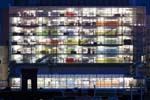 (Tom Arban) Terrence Donnelly Center for Cellular and Biomolecular Research: painted colored walls enliven the building after dark.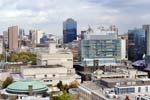 (Tom Arban) The new structure emerges gracefully over the neighboring buildings, creating an altered cityscape that is a blend of historic and contemporary architecture.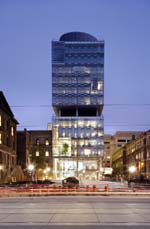 (Tom Arban) TDCCBR is sandwiched between two existing historical structures: the Rosebrugh Building to the west and the Fitzgerald Building to the east.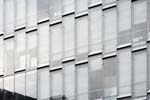 (Tom Arban) Glass surfaces allow a strong day lighting program, with all façades having operable windows and interior sun blinds.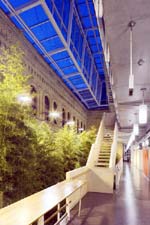 (Tom Arban) The small site required an unusual design strategy, which was to abut the new structure directly against the historic Rosebrugh Building.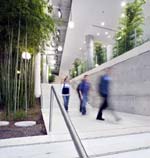 (Tom Arban) Granite on the exterior forecourt continues into the building, creating an indoor-outdoor sensibility that is further established by lush interior gardens.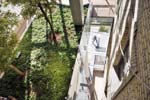 (Tom Arban) An interior deck, ideal for quiet respite, is lined with 45-foot-high bamboo trees and Liriope grass.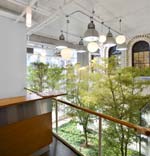 (Tom Arban) Indoor gardens, irrigated and drained as part of the building’s storm-water reclamation system, thrive throughout the building.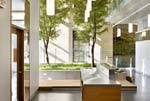 (Tom Arban) The gardens throughout the facility act as lounges for relaxation and informal meetings. (Tom Arban) On the ground floor, the line between indoor and outdoor is blurred, as trees line walkways. (Tom Arban) The plantings create an invigorating micro-climate where visitors, employees, and those pass through can relax and converse.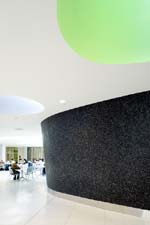 (Tom Arban) Tinted, amorphously-shaped ceiling recesses and the black-mosaic walls of a seminar room enliven the public spaces.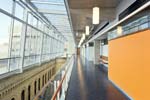 (Tom Arban) Open circulation stairways and informal meetings spaces foster communication and promote collaboration among the organization’s various disciplines.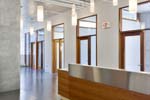 (Tom Arban) Each level has six principal-researchers’ offices, 38 research-associate stations, lounges, cold rooms, and equipment rooms.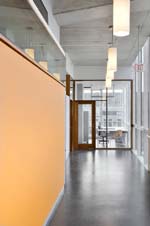 (Tom Arban) Colorful walls that face glass windows can be seen from the outside. (architectsAlliance/Behnisch Architekten) East and west elevations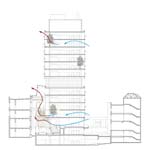 (architectsAlliance/Behnisch Architekten) Diagram of natural air flow through public spaces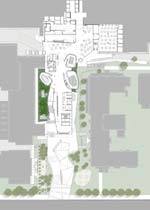 (architectsAlliance/Behnisch Architekten) Ground floor plan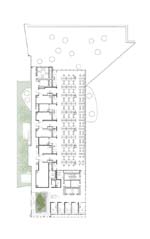 (architectsAlliance/Behnisch Architekten) Typical lab floor plan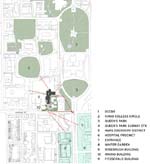 (architectsAlliance/Behnisch Architekten) Site plan illustrates TDCCBR’s relationship to surrounding campus and neighborhood |
© 2006 ArchNewsNow.com